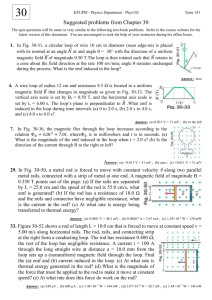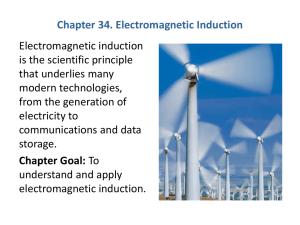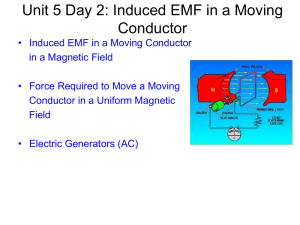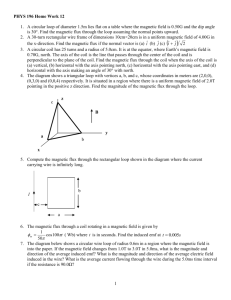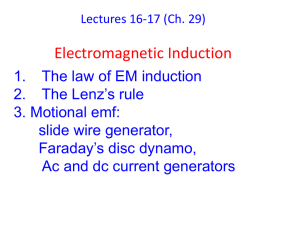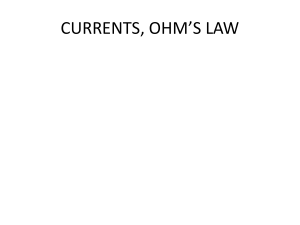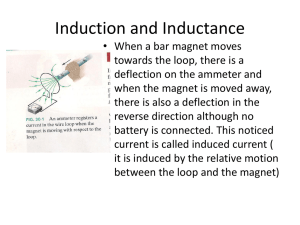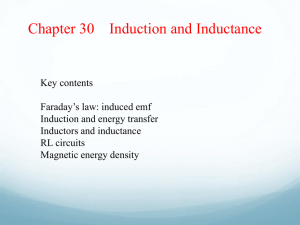Chapter30 - Academic Program Pages at Evergreen
advertisement
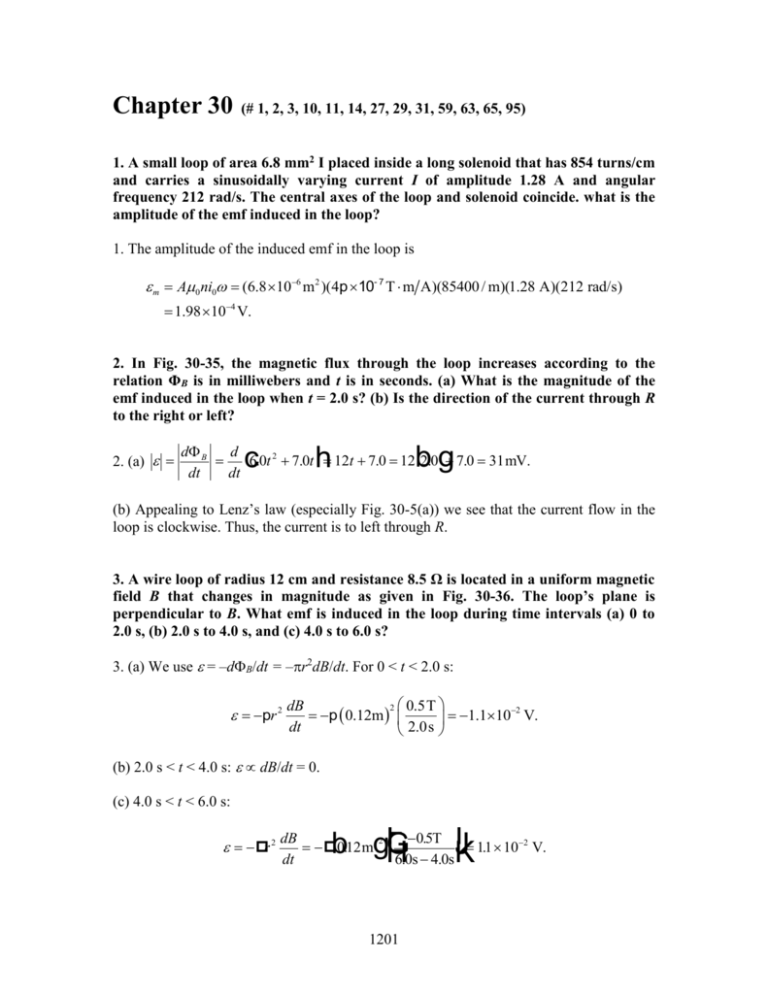
Chapter 30 (# 1, 2, 3, 10, 11, 14, 27, 29, 31, 59, 63, 65, 95) 1. A small loop of area 6.8 mm2 I placed inside a long solenoid that has 854 turns/cm and carries a sinusoidally varying current I of amplitude 1.28 A and angular frequency 212 rad/s. The central axes of the loop and solenoid coincide. what is the amplitude of the emf induced in the loop? 1. The amplitude of the induced emf in the loop is m A0 ni0 (6.8 106 m 2 )(4p 10- 7 T m A)(85400 / m)(1.28 A)(212 rad/s) 1.98 104 V. 2. In Fig. 30-35, the magnetic flux through the loop increases according to the relation ΦB is in milliwebers and t is in seconds. (a) What is the magnitude of the emf induced in the loop when t = 2.0 s? (b) Is the direction of the current through R to the right or left? 2. (a) d B d 6.0t 2 7.0t 12t 7.0 12 2.0 7.0 31 mV. dt dt c bg h (b) Appealing to Lenz’s law (especially Fig. 30-5(a)) we see that the current flow in the loop is clockwise. Thus, the current is to left through R. 3. A wire loop of radius 12 cm and resistance 8.5 Ω is located in a uniform magnetic field B that changes in magnitude as given in Fig. 30-36. The loop’s plane is perpendicular to B. What emf is induced in the loop during time intervals (a) 0 to 2.0 s, (b) 2.0 s to 4.0 s, and (c) 4.0 s to 6.0 s? 3. (a) We use = –dB/dt = –r2dB/dt. For 0 < t < 2.0 s: pr 2 dB 2 0.5T 2 p 0.12m 1.110 V. dt 2.0s (b) 2.0 s < t < 4.0 s: dB/dt = 0. (c) 4.0 s < t < 6.0 s: r 2 0.5T I b gF G H6.0s 4.0sJ K 11. 10 dB 012 . m dt 2 1201 2 V. 1202 CHAPTER 30 10. In Fig. 30-41a, a uniform magnetic field B increases in magnitude with time t as given by Fig. 30-41b. A circular conducting loop of area 8.0 × 10-4 m2 lies in the field, in the plane of the page. The amount of charge q passing point A on the loop is given in Fig. 30-41c as a function of t. What is the loop’s resistance? dB 10. Fig. 30-41(b) demonstrates that dt (the slope of that line) is 0.003 T/s. Thus, in absolute value, Faraday’s law becomes dΦB dB = dt = A dt where A = 8 ×104 m2. We related the induced emf to resistance and current using Ohm’s dq law. The current is estimated from Fig. 30-41(c) to be i = dt = 0.002 A (the slope of that line). Therefore, the resistance of the loop is R = || / i = (8 x 10-4 )(0.003) = 0.0012 . 0.002 11. A rectangular coil of N turns and length a and width b is rotated at frequency f in a uniform magnetic field B, as indicated in Fig. 30-42. The coil is connected to corotating cylinders, against which metal brushes slide to make contact. (a) Show that the emf induced in the coil is given (as a function of time t) by ξ = 2πfNabB sin(2πft) = ξ0 sin(2πft). This is the principle of the commercial alternating-current generator. (b) What value of Nab gives an emf with ξ0 = 150 V when the loop is rotated at 60.0 rev/s in a uniform magnetic field of 0.500T? 11. (a) It should be emphasized that the result, given in terms of sin(2 ft), could as easily be given in terms of cos(2 ft) or even cos(2 ft + ) where is a phase constant as discussed in Chapter 15. The angular position of the rotating coil is measured from some reference line (or plane), and which line one chooses will affect whether the magnetic flux should be written as BA cos, BA sin or BA cos( + ). Here our choice is such that B BA cos . Since the coil is rotating steadily, increases linearly with time. Thus, = t (equivalent to = 2 ft) if is understood to be in radians (and would be the angular velocity ). Since the area of the rectangular coil is A=ab , Faraday’s law leads to d BA cos d cos 2 ft N NBA N Bab2 f sin 2 ft dt dt 1203 which is the desired result, shown in the problem statement. The second way this is written (0 sin(2ft)) is meant to emphasize that the voltage output is sinusoidal (in its time dependence) and has an amplitude of 0 = 2f N abB. (b) We solve 0 = 150 V = 2f N abB when f = 60.0 rev/s and B = 0.500 T. The three unknowns are N, a, and b which occur in a product; thus, we obtain N ab = 0.796 m2. 14. At a certain place, Earth’s magnetic field has magnitude B = 0.590 gauss and is inclined downward at an angle of 70.0º to the horizontal. A flat horizontal circular coil of wire with a radius of 10.0 cm has 1000 turns and a total resistance of 85.0 Ω. It is connected in series to a meter with 140 Ω resistance. The coil is flipped through a half-revolution about a diameter, so that it is again horizontal. How much charge flows through the meter during the flip? 14. We note that 1 gauss = 10–4 T. The amount of charge is N 2 NBA cos 20 [ BA cos 20 ( BA cos 20)] R R 4 2 2(1000)(0.590 10 T)(0.100 m) (cos 20) 1.55 105 C . 85.0 140 q(t ) Note that the axis of the coil is at 20°, not 70°, from the magnetic field of the Earth. 27. If 50.0 cm of copper wire (diameter = 1.00 mm) is formed into a circular loop and places perpendicular to a uniform magnetic field that is increasing at the constant rate of 10.0 mT/s, at what rate is thermal energy generated in the loop? 27. Thermal energy is generated at the rate P = 2/R (see Eq. 27-23). Using Eq. 27-16, the resistance is given by R = L/A, where the resistivity is 1.69 10–8 ·m (by Table 27-1) and A = d2/4 is the cross-sectional area of the wire (d = 0.00100 m is the wire thickness). The area enclosed by the loop is FL I G J H2 K 2 Aloop r 2 loop since the length of the wire (L = 0.500 m) is the circumference of the loop. This enclosed area is used in Faraday’s law (where we ignore minus signs in the interest of finding the magnitudes of the quantities): d B dB L2 dB Aloop dt dt 4 dt 1204 CHAPTER 30 where the rate of change of the field is dB/dt = 0.0100 T/s. Consequently, we obtain d i L2 dB 2 4 dt F IJ 3.68 10 G HK d 2 L3 dB P 4 L / d 2 64 dt 2 6 W. 29. In Fig. 30-52, a metal rod is forced to move with constant velocity v along two parallel metal rails, connected with a strip of metal at one end. A magnetic field of magnitude B = 0.350 T points out of the page. (a) If the rails are separated by 25.0 cm and the speed of the rod is 55.0 cm/s, what emf is generated? (b) If the rod has a resistance of 18.0 Ω and the rails and connector have negligible resistance, what is the current in the rod? (c) At what rate is energy being transferred to thermal energy? 29. (a) Eq. 30-8 leads to BLv (0.350 T)(0.250 m)(0.55 m / s) 0.0481 V . (b) By Ohm’s law, the induced current is i = 0.0481 V/18.0 = 0.00267 A. By Lenz’s law, the current is clockwise in Fig. 30-52. (c) Eq. 26-22 leads to P = i2R = 0.000129 W. 31. The conducting rod shown in Fig. 30-52 has length L and is being pulled along horizontal, frictionless conducting rails at a constant velocity v. The rails are connected at one end with a metal strip. A uniform magnetic field B, directed out of the page, fills the region in which the rod moves. Assume that L = 10 cm, v = 5.0 m/s, and B = 1.2 T. What are the (a) magnitude and (b) direction (up or down the page) of the emf induced in the rod? What are the (c) size and (d) direction of the current in the conducting loop? Assume that the resistance of the rod is 0.40 Ω and that the resistance of the rails and metal strip is negligibly small. (e) At what rate is thermal energy being generated in the rod? (f) What external force on the rod is needed to maintain v? (g) At what rate does this force do work on the rod? 31. (a) Eq. 30-8 leads to BLv (1.2 T)(0.10 m)(5.0 m/s) 0.60 V . (b) By Lenz’s law, the induced emf is clockwise. In the rod itself, we would say the emf is directed up the page. (c) By Ohm’s law, the induced current is i = 0.60 V/0.40 = 1.5 A. (d) The direction is clockwise. 1205 (e) Eq. 27-22 leads to P = i2R = 0.90 W. (f) From Eq. 29-2, we find that the force on the rod associated with the uniform magnetic field is directed rightward and has magnitude F iLB (15 . A)(010 . m)(1.2 T) 018 . N. To keep the rod moving at constant velocity, therefore, a leftward force (due to some external agent) having that same magnitude must be continuously supplied to the rod. (g) Using Eq. 7-48, we find the power associated with the force being exerted by the external agent: P = Fv = (0.18 N)(5.0 m/s) = 0.90 W, which is the same as our result from part (e). 59. At rate t = 0, a battery is connected to a series arrangement of a resistor and an inductor. If the inductive time constant is 37.0 ms, at what time is the rate at which energy is dissipated in the resistor equal to the rate at which energy is stored in the inductor’s magnetic field? 59. From Eq. 30-49 and Eq. 30-41, the rate at which the energy is being stored in the inductor is 2 1 2 dU B d 2 Li di 1 t L Li L 1 e t L e 1 et L et L dt dt dt R R L R where L = L/R has been used. From Eq. 26-22 and Eq. 30-41, the rate at which the resistor is generating thermal energy is Pthermal i R 2 2 R2 2 c1 e hR R c1 e h. t L 2 t L 2 We equate this to dUB/dt, and solve for the time: 2 1 e c 1 e c h he R R t L 2 2 t L t L b g t L ln 2 37.0 ms ln 2 25.6 ms. 63. A solenoid that is 85.0 cm long has a cross-sectional area of 17.0 cm2. There are 950 turns of wire carrying a current of 6.60 A. (a) Calculate the energy density of the magnetic field inside the solenoid. (b) Find the total energy stored in the magnetic field there (neglect and effects). 1206 CHAPTER 30 63. (a) At any point the magnetic energy density is given by uB = B2/20, where B is the magnitude of the magnetic field at that point. Inside a solenoid B = 0ni, where n, for the solenoid of this problem, is (950 turns)/(0.850 m) = 1.118 103 m–1. The magnetic energy density is uB c hc 1 1 0n 2i 2 4 107 T m A 1118 . 103 m1 2 2 hb6.60 Ag 34.2 J m 2 2 3 . (b) Since the magnetic field is uniform inside an ideal solenoid, the total energy stored in the field is UB = uB, where is the volume of the solenoid. is calculated as the product of the cross-sectional area and the length. Thus d hb ic g U B 34.2 J m 17.0 104 m2 0.850 m 4.94 102 J . 3 65. What must be the magnitude of a uniform electric field if it is to have the same energy density as that possessed by a 0.50 T magnetic field? 65. We set uE 21 0 E 2 uB 21 B 2 0 and solve for the magnitude of the electric field: E B 0 0 0.50 T c8.85 10 12 hc 15 . 108 V m . h F m 4 7 H m 95. (a) What is the energy density of Earth’s magnetic field, which has a magnitude of 50 µT? (b) Assuming this density to be relatively constant over distances much smaller than Earth’s radius and neglecting variations near the magnetic poles, how much energy would be stored between Earth’s surface and a spherical shell 16 km above the surface? 95. (a) The energy density is c c h 2 50 106 T Be2 uB 10 . 103 J m3 . 2 0 2 4 107 H m h (b) The volume of the shell of thickness h is V 4Re2 h , where Re is the radius of the Earth. So U B VuB 4 m 16 103 m 1.0 103 J m3 8.4 1015 J. 2

